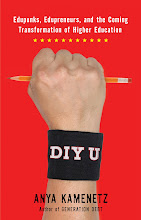The below video, by e-textbook company CourseSmart, is a neat demo of the educational advantages of the iPad: keep all your textbooks in one slender, elegant package; highlight and make notes; watch embedded video and multimedia; browse the web for supplementary material; chat and collaborate with classmates and teachers as you read. These innovations are exciting for colleges that want to be tech savvy. "I do see our university replacing our [standard undergrad-issued] laptop computer with this new iPad," wrote one CIO of an Oregon university.
A bigger question is whether they can cut costs at the same time. Textbooks cost the average college student more than $1000 a year,; electronic content can be much less, especially when it's open-source. The open-license textbook company Flat World Knowledge estimated it saved students a collective $3 million just this past fall. The iPad uses the open ePub format for electronic books, which should be a boon to the burgeoning open education movement.
However, Joshua Kim, a technology blogger at Inside Higher Ed, asks whether the iPad is a "sustaining" rather than a "disruptive" innovation. The danger is that colleges spend even more money and faculty time on purchasing and developing content for these new gadgets, as they have on the generations of tech that came before, without making cuts elsewhere. This is one reason tuition keeps growing faster than inflation. "The possibilities for learning, student interaction and
enhanced campus services that the iPad unleashes will all come at a
price. Nothing about a tool as wonderful as the iPad will lower the
cost of constructing or delivering education."
That is, costs won't come down unless universities act, boldly, to fully replace part of the butts-in-seats classroom model with mobile, wireless, open-source education.


